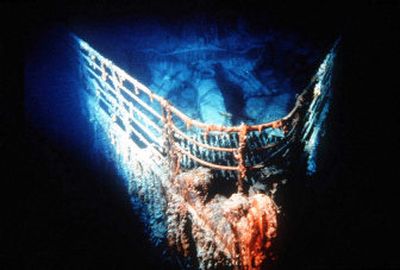Rivets may have doomed Titanic

PORTLAND – More than 1,500 people died when the Titanic sank in 1912, two hours and 40 minutes after it collided with an iceberg. Why the luxurious ocean liner sank so fast has been the subject of speculation ever since.
But a Portland scientist has done some old-fashion detective work and laboratory tests to figure out why.
One prominent theory blamed the hull’s steel plates for being so brittle that they shattered during the collision. But once the sunken ship was found and examined – revealing not a single massive gash in its side but six slits spread across a wide area – some theorists focused on the wrought-iron rivets that held the steel plates together.
Jennifer Hooper McCarty, a licensing associate in the Office of Technology & Research Collaborations at Oregon Health & Science University, was a graduate student at Johns Hopkins University seven years ago. She was looking for a dissertation topic when her thesis supervisor, Dr. Tim Foecke at the National Institute of Standards & Technology, suggested she put the rivet theory to the test. Foecke was an early theorist about the rivets’ role and had conducted early laboratory tests on the rivets’ formulation.
“It was just a theory,” she said in an interview. “The problem with the Titanic is there are so many theories. They get picked up, and people run with them. Now we’ve got the science and the history, and they’re intertwined. It makes a nice complete picture.”
She first confirmed earlier tests by Foecke that showed the rivets were made weak with too much slag, a byproduct of the process of making wrought iron. Rivets of purer iron would have remained strong under stress and kept the ship together longer.
She examined every one of the 48 rivets recovered from the 3 million used to build the ship. What she discovered in the lab confirmed speculation. Some of the rivets she examined showed slag levels as high as 40 percent.
A 2 percent or 3 percent presence of slag is known to reinforce iron, but even slightly higher concentrations start to turn the metal brittle. In that circumstance, it fails to withstand shear forces and breaks.
McCarty performed mechanical tests on small pieces that correlated with what she saw under the microscope: The samples broke. Computer models then simulated the system, and failure followed again.
She pored over historical records for answers. Looking at witness accounts led her to re-imagine the collision.
“A lot of survivors didn’t even feel it, and some talk about it as a glancing blow type thing,” she said. “The flooding and the timeline – it’s not consistent with something that opened a gaping hole. Yes, it sank quickly, but the initial flooding happened with water coming through a seam.”
Outside the lab, she researched shipyard records and discovered that rivets were purchased from several forges – with varying but high slag content. She looked at minutes from Board of Trade meetings that told her the Titanic’s owners were in a hurry to get the ship built and hiring thousands of new workers of varying levels of skill in the months leading up to completion.
At the same time, the Titanic’s sister ship, the Olympic, came back into the shipyard for repairs, increasing the need for skilled riveters and adding pressure to the shipbuilding schedule. McCarty investigated how shipyard workers were trained, how they lived, and what working conditions were like. She also examined the records of both inquiries following the incident.
Perhaps the most dramatic thing she and Foecke did to prove their case was take all their findings and put them together for a National Geographic channel program that aired recently. A blacksmith in England was hired to re-create hull plates and rivets to specifications of the day for testing under strain.
“We basically re-created the collision scenario using materials as close as we could get as to what was on the Titanic,” she said.
When the test was performed, the rivets started popping sooner than they should have. The theory that the Titanic’s hull plates opened up like a zipper found its strongest evidence yet.
“We wanted to prove this and establish this in the scientific community, as well as the Titanic community,” she said. “Everything had to match up, and it did.”
The onslaught of attention and publicity that has followed her findings has not surprised her.
“I guess people feel like it’s always been an unanswered question, and they’re intrigued by the combination of events,” said McCarty, who has written a book with Foecke that is not yet published.
“It’s one of those instances where I think the public wants a way to explain these things. This adds to it. There’s always going to be theories. People are just drawn to this idea that (the Titanic was) state-of-the-art, and it completely failed.”